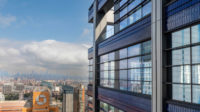LNAI Architecture Unwraps a 1960s Office Building and Reinvents It as a New Kind of Workplace

Architects & Firms
Like all veils, this one balances privacy and transparency, gesture and function. Made of lightweight aluminum slats coated with synthetic film that gives it the look of wood, the architectural veil at Origami Offices in San Mateo, California, screens the ground floor, then beckons pedestrians with a flirtatious twist above the building’s deeply recessed entryway. Glazing above the entry reveals the dynamic geometry of the twist—inspired by hyperbolic paraboloids—and serves as part of the street-front seduction.

The twisting feature above the entryway was inspired by hyperbolic paraboloids. Photo © Matthew Millman

A vertical wood screen shields the ground-level offices from the sun while providing privacy. Photo © Matthew Millman
Hidden within this sleek 12,000 square-foot office building are the bones of a 1960s structure saddled with inefficient mechanical systems, low ceilings, and accessibility challenges. Set in the northern part of Silicon Valley not far from San Francisco, the property had trouble attracting the start-ups and tech companies that were driving the local economy. So Leonard Ng and his firm LNAI Architecture—based in neighboring Burlingame— gutted the old building, inserted a new steel-moment-frame structure within the existing wood frame, poured new concrete floors, installed modern electrical and HVAC systems, and carved out a small courtyard in the middle. A new ADA lift at the entry and an elevator near the back make the building accessible to everyone. The project opened at the end of 2023.

The 1960s-era office building had fallen into a state of disrepair. Photo courtesy LNAI Architecture
Ng, who studied architecture and civil engineering at the Massachusetts Institute of Technology and then earned a master’s from the Harvard Graduate School of Design, says, “I’ve always been fascinated by the intersection of mathematics and architecture.” In particular, he has been attracted to the hyperbolic geometries of Félix Candela, which informed his design of Origami Offices. Ng collaborated with the product and fabrication team at a Japanese supplier to develop the project’s twisting feature made from straight members that tilt and angle as they move from street to upper level and connect to each other by means of a concealed, hinged system. The hollow aluminum extrusions are much lighter and water-resistant than wood and require little maintenance, says Ng. Warping and folding both inward and upward, they allude to origami, the Japanese artform that manipulates flat sheets of paper into three-dimensional forms.

1

2
The slats are composed of special wood veneer–clad aluminum louvers, fabricated and shipped directly from Japan. (1,2). Photos © Matthew Millman
After being lured in by the sculptural entry feature, visitors move through a covered vestibule and into the two-story-high courtyard topped with a gabled skylight. Sitting above an open clerestory, the skylight allows air to flow inside and naturally ventilate the courtyard, which is landscaped with plants, precast-concrete pavers, and wood benches. A pair of stairs anchors each side of the courtyard and walkways on the second floor overlook the landscaped space, so none of the circulation areas require air conditioning.
.webp)
3
.webp)
4
.webp)
5
A greenery-filled courtyard at the center of the building promotes fresh air, natural daylight, and interaction between tenants. (3,4,5). Photos © Matthew Millman
Each floor offers about 6,000 square feet of office space with seven suites that can be combined as tenants see fit. Daylight from perimeter glazing and the central courtyard reduce energy consumption and make the offices conducive to work.
“I was striving for simplicity while creating something dynamic,” says Ng. “The key was to make everything feel integral.” To that end, he stripped the old building of its fussy facade, emphasized its rectilinear form, simplified its material palette, and choreographed a clear procession into and through it. Although new, the courtyard seems so essential it’s hard to imagine the building without it. Like a perfect martini, the project employs just a few ingredients then adds a twist in the right place.







